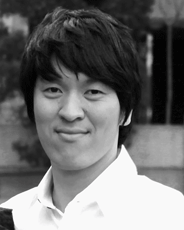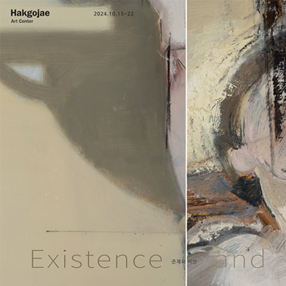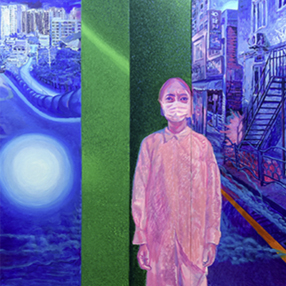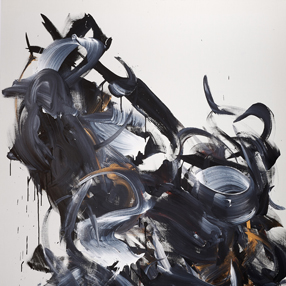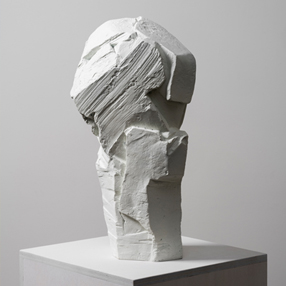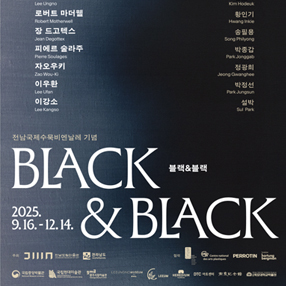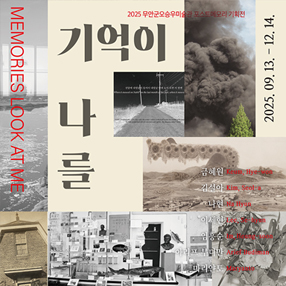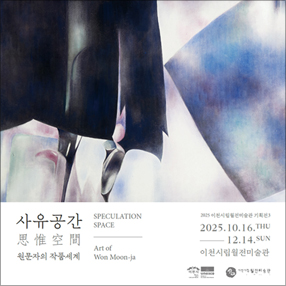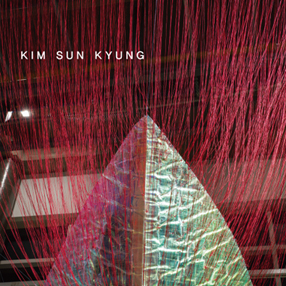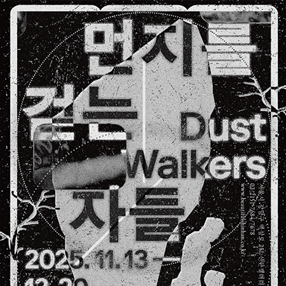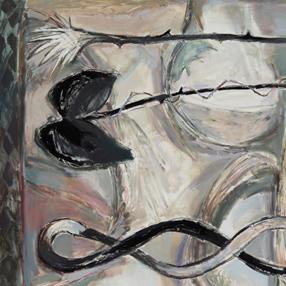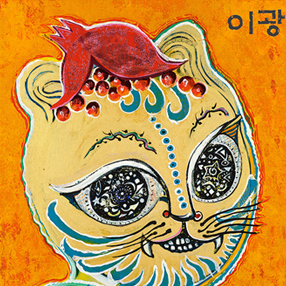본문
-
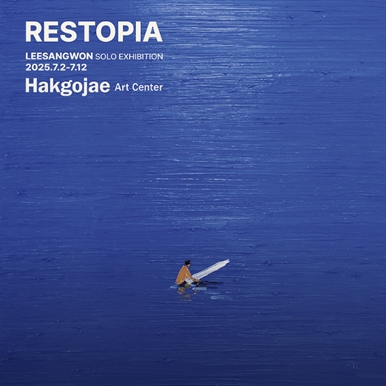
전시 포스터
-
Press Release
이상원의 Restopia
일상군상(日常群像), 우리 시대를 담은 감성붓질
안현정 (미술평론가, 예술철학박사, 성균관대학교박물관 학예실장)
“나는 사람들의 풍경을 그린다. 그들은 어떤 인물보다도 생생하다. 그들의 걷는 방식, 손짓, 시선의 방향, 때로는 나도 모르게 그들과 함께 그 풍경 속에 들어가 있다. 화면속 사람들은 나와 닮아있고, 또 모두와 닮아있다. Restopia는 쉼을 위한 곳이 아니 다. 쉼을 바라는 감정들이 부딪히는 공간이다. 나는 그 감정을 색과 붓질로 남기고 싶었다.”
이상원의 작가노트는 회화가 지닌 이중적 태도—관찰자이면서도 감정의 참여자—를 함축적으로 드러낸다. 단순히 풍경을 묘사하는 작가가 아니라, 풍경 속의 감정을 시각 화하는 감정의 통역자라는 뜻이다. 그의 작업은 실천적 회화이자 감각의 아카이브이 다. 그 감정의 언어는 동양의 심재(心齋)를 닮았고, 서구 현상학이 말하는 ‘살 속의 시선’과도 교차한다. 이상원은 동시대의 윤동주처럼, ‘일상의 시(詩)’를 회화로 옮긴다.
Restopia: 감정의 풍경, 공감의 지도
디스토피아적 현실 속에서 회화가 보여줄 수 있는 유토피아는 무엇인가? 이상원의 《레스토피아(Restopia)》는 그 질문에 감정으로 응답하는 하나의 회화적 제안이다. 이연작은 동시대 일상을 감각적으로 포착하면서도, 그 내부에 담긴 집단 정서를 섬세히 그려낸다. 특히 코로나19 팬데믹 이후, 해외 이동이 어려웠던 시기, 한국의 컬렉터들과 관객들에게 Restopia는 마치 ‘오랑주리 미술관의 모네’를 찾듯 하나의 치유 풍경이 되었다. 이 회화는 미술시장 바깥에서도 하나의 문화적 현상이 되었고, SNS를 중심으로 폭발적인 관심을 끌며 ‘힐링 회화’라는 새로운 장르를 제안했다. 회화는 디지털 시대에 더욱 감각적 유효성을 요구받는다. 디지털 이미지의 포화 속에서, 인간은더 느리고 더 깊이 있는 감각을 원하게 되었고, 작가는 그 요구에 정확히 응답한다.
색채는 정보가 아니라 감정의 파장으로, 시점은 재현이 아니라 사유의 각도로, 인물은 형상이 아니라 감정의 캐리어로 전환된다. 그의 작품은 동시대 회화가 도달한 한 지점이자 새로운 감성의 지형도이며, 우리에게 새로운 질문을 던진다. “지금 우리는 어디에 있으며, 어떤 감정 속에 존재하는가?” 작가는 조용히 응답한다. “이 감정은 너의 것이기도 하다.”라고. 이 고백은 회화가 단순한 장면의 재현이 아니라 감정의 현장 임을 말해준다. Restopia는 더 이상 ‘쉼’을 위한 공간이 아닌, 서로 다른 감정들이 부딪히는 공공의 장소다. 작가는 그 복잡한 감정을 붓질과 색채로 기록하며, 익명의 군중 안에서 감정의 흔적을 길어낸다.
작가의 회화는 빠르게 소비되는 디지털 이미지와 달리, ‘응시’를 회복하는 느림의 예술이다. 색은 감정의 파장이며, 시점은 단지 위에서 보는 각도가 아니라 인간과 세계 사이의 거리감, 혹은 사유의 깊이다. Restopia는 작가 개인의 회화적 여정이자, 한국 화의 전통이 글로벌 감각과 교차하는 지점이다. 20세기 초 윤동주(尹東柱, 1917~1945)의 시가 일상의 언어로 시대의 아픔을 포착했다면, 이상원의 회화는 21세기 도시인의 일상을 통해 감정의 위상을 복원한다. Restopia 속 인물들은 이름이 없다. 얼굴도 없다. 그러나 그들은 어떤 서사보다 생생하게 우리 안의 감정을 흔든다.
이 회화는 ‘나-너-우리’라는 한국적 관계의 틀 안에서 감정을 조직하고, 그것을 시각 화하는 ‘감정 공동체의 지도’이기도 하다. 이는 동양철학의 관계성 개념(仁, 緣起)에 뿌리를 두고 있으며, 서구현상학이 강조한 개인적 체험을 넘어선 공동체적 사유의 실천이다.
일상군상(日常群像), 동시대 감정의 조형어법
이상원의 군상은 서세옥과 이응노의 추상적 인물군상(人物群像)과 연결되지만, 2020 년대의 구체적 감정, 일상, 생활의 장면을 담고 있다는 점에서 독보적이다. 작가는 계급 없이 평등한 일상 속 존재들을 유사한 크기와 형태로 화면 가득히 채워낸다. 그풍경은 다층적인 감정의 필터로 구조화된 사회학적 이미지이며, 관계의 물결이자 감정의 파동이다. 작가의 회화는 일상의 시간성과 감각적 층위를 결합한 하나의 ‘감정의 풍경화’로 기능한다. 더 나아가 작가의 회화는 에드워드 호퍼(Edward Hopper, 1882~1967)의 고립된 인물들과도 닮아있다. 그러나 호퍼가 근대적 불안과 정적을 강조했다면, 이상원은 그 안에 감정의 네트워크와 집단적 리듬을 복원한다. 또한 데이비드 호크니(David Hockney, 1937~)가 보여준 팝적 구성과 색면 구성과도 차별화되 며, 작가 고유의 붓질과 조형 감각은 ‘일상적 감정의 조형어법’으로 한국적 회화의 새로운 가능성을 제시한다. 이 덤덤한 시선은 장자의 ‘심재(心齋)’ 개념과 연결되며, “무 위(無爲)로서 관조하라!”는 동양적 무심(無心)의 미학과도 통한다. 동시에 모리스 메를 로퐁티(Maurice Merleau Ponty, 1908~1961)의 현상학적 시선처럼, “보는 자와 보이는 것의 상호침투”를 구현한다. 이는 ‘감정의 풍경’이 단순히 외부의 재현이 아니 라, 관람자의 내면과 상호작용하는 장이라는 것을 시사한다.
이상원의 회화는 구상과 추상의 경계에서 이루어진다. 화면을 가득 채운 인물들의 군상은 일종의 ‘올오버 회화(All over painting)’처럼 균일하게 펼쳐져 있다. 이는 단순한 조형의 반복이 아니라, 동시대를 살아가는 ‘평준화된 존재들’의 총체를 그려낸다.
시점의 선택은 주목할 만하다. 부감(俯瞰) 시점은 만화적 패널 구성을 연상시키며, 기계적 시선을 담은 현대적 시점이지만 동시에 한국미술사의 철학을 계승하는 고찰의 시선이다. 작가는 관찰자이자 감정의 참여자다. 이 이중성은 그의 회화를 거리와 친밀함 사이를 오가게 만든다. 정제된 붓질과 조형감각은 동시대 작가 중 단연코 탁월하다. 이상원의 Restopia는 단순한 연작이 아닌, 한국미를 재정의하고 글로벌 담론과 조우시키는 회화적 철학이다. 반복적 군상과 조화로운 리듬의 부감 시점은 서세옥과 이응노의 군상 전통을 계승하며, ‘일상군상’을 21세기 감정의 민속학으로 변모시킨다.
붓질 역시 단색화의 촉각성과 통하지만, 동시대 감수성을 담은 감정 회화로 독자적 브랜딩을 확립한다. 인물은 단순한 형상이 아니라 ‘우리 시대의 매개자’이며, 화면 속에서 ‘동시대의 드라마’를 연출한다. 지금 이 시대에 이상원의 회화는 시선의 회복, 감정의 귀환, 느림의 미학을 가능케 한다. 이렇듯 일상군상은 관계를 드러낸 서사시 (敍事詩)이자, 감정의 풍경시(風景詩)가 아닐까.
“Restopia는 쉼이자 질문의 공간이다. 나는 이 이미지 안 어디쯤에 있는가?”
Everyday Figures, Emotional Brushstrokes of Our Time
Ahn Hyun-jung (Art Critic, Ph.D. in Aesthetics, Chief Curator at Sungkyunkwan University Museum)
“I paint landscapes of people. They are more vivid than any individual. The way they walk, gesture, where they look—sometimes I find myself inside that very scene. The figures in my paintings resemble me, and they resemble everyone. Restopia is not a place for rest—it is a space where the desire for rest collides. I wanted to preserve those emotions through color and brushwork.”
In this note, artist Lee Sang-won encapsulates the dual role of painting—as both observer and participant of emotion. He is not merely a documenter of daily scenery, but a translator of emotional topographies. His work is a praxis of painting and an archive of sensation. It echoes the Eastern notion of simjae (心齋, the heart-mind’s stillness), while simultaneously resonating with the Western phenomenological concept of "the gaze from within the flesh." Like a contemporary Yun Dong-ju, Lee writes the "poetry of the everyday" through paint.
Restopia: Emotional Landscapes, Maps of Empathy
What kind of utopia can painting offer in our dystopian times? Lee Sang-won’s Restopia responds to this question through emotion. The series captures contemporary everyday life with sensory immediacy while delicately portraying its shared emotional undercurrents. Especially during the post-pandemic period when international travel was restricted, Restopia became a healing landscape for Korean collectors and viewers—much like the Monet galleries in the Musée de l'Orangerie offer to Parisians. Beyond the art market, the series emerged as a cultural phenomenon, gaining viral traction on social media and coining the genre of "healing painting."
In the image-saturated digital age, painting must assert its sensorial legitimacy. As humans seek slower, deeper modes of perception, Lee responds with precision: color becomes a wave of emotion rather than information; perspective becomes a mode of reflection rather than depiction; and the figure becomes a vessel of feeling rather than form. His canvases mark a critical moment in contemporary painting and propose a new emotional cartography. His implicit question—“Where are we now, and in what emotion do we exist?”—finds its answer in the quiet assertion:
“This feeling is yours too.” Restopia thus becomes not a sanctuary, but a shared arena of clashing emotions, with Lee’s brushwork tracing their ephemeral residues among anonymous crowds.
Unlike the fast-consumed digital image, Lee’s paintings restore the art of sustained looking. Color is the frequency of emotion; perspective is not just an angle, but the measured distance between self and world. Restopia is both a personal painterly journey and a site where the traditions of Korean painting intersect with global sensibilities. If poet Yun Dong-ju once distilled an epoch's pain into the language of daily life, Lee Sang-won reclaims the dignity of emotion through the daily routines of the 21st-century urbanite. His figures are nameless, faceless—yet more vivid than any narrative. His work constitutes a map of emotional community within the Korean relational framework of Na-Neo-Uri (I–You–We), deeply rooted in Confucian concepts of In (仁, benevolence) and Buddhist Yeongi (緣起, dependent origination). It is also a practice of communal phenomenology, transcending Western individualism.
The Drama of the Everyday: A Visual Syntax of Emotion
Lee’s massed figures recall the abstract human forms of Suh Se-ok and Lee Ung-no, yet they distinguish themselves by embedding concrete emotions and urban scenes specific to the 2020s. Eschewing hierarchy, he fills the canvas with uniformly rendered figures, constructing a sociological image structured by layers of emotional filters—waves of relation and pulses of feeling. These works function as emotional landscapes that merge the temporal quality of daily life with layers of sensory experience.
His work evokes Edward Hopper’s solitude but restores the emotional rhythms of the collective. While Hopper depicted modern isolation and stillness, Lee reconstructs networks of shared emotion. Unlike David Hockney’s pop-inflected composition and color planes, Lee’s brushwork and formal intuition suggest a new lexicon for "everyday emotion" within Korean painting. His detached gaze aligns with Zhuangzi’s simjae, echoing the Eastern aesthetic of wuwei (無為, effortless action) and contemplative detachment, while also embodying Maurice Merleau-Ponty’s phenomenological vision of the “interpenetration between the seer and the seen.” This implies that Lee’s "emotional landscapes" are not just external depictions but interactive spaces where the viewer’s inner world resonates.
Situated between figuration and abstraction, Lee’s compositions resemble all-over painting—populated edge to edge with figures. This is not mere repetition but a reflection of the homogenized existence of our times. His use of the bird’s-eye view is notable: it recalls comic strip panels and mechanically detached perspectives, yet also carries the introspective depth of traditional Korean visual philosophy. As both observer and emotional participant, Lee oscillates between distance and intimacy. His brushwork and visual command stand among the finest of his generation.
Restopia is not just a series—it is a painterly philosophy that redefines Korean aesthetics and intersects with global discourses. Its repetitive masses and balanced rhythm inherit the gun-sang (群像, massed figures) tradition of Suh Se-ok and Lee Ung-no, transforming it into an ethnography of 21st-century emotion. His tactile brushwork resonates with the sensibility of Dansaekhwa (Korean monochrome painting), yet achieves a distinct branding as emotional painting rooted in contemporary experience. His figures are not merely forms but intermediaries of our time —composing the “drama of the present” on canvas. In this era, Lee’s work enables a return to vision, to emotion, and to the aesthetics of slowness.
Indeed, Restopia is both sanctuary and inquiry. It asks, “Where am I within this image?” and invites us, quietly but insistently, to look closer.전시제목이상원 | Restopia
전시기간2025.06.02(월) - 2025.07.12(토)
참여작가 이상원
관람시간10:00am - 06:00pm
휴관일매주 일요일, 월요일 휴무
장르회화
관람료없음
장소학고재 아트센터 Hakgojae Art Center (서울 종로구 삼청로 48-4 (소격동, 학고재) 학고재아트센터 B2)
연락처02-739-4937
-
Artists in This Show
-
1978년 충남 청양출생
-
학고재 아트센터(Hakgojae Art Center) Shows on Mu:umView All
Current Shows
-
정현: 그의 겹쳐진 순간들
PKM 갤러리
2025.10.22 ~ 2025.12.13
-
BLACK & BLACK
전남도립미술관
2025.09.16 ~ 2025.12.14
-
기억이 나를 본다
무안군오승우미술관
2025.09.13 ~ 2025.12.14
-
원문자: 사유공간 思惟空間
이천시립월전미술관
2025.10.16 ~ 2025.12.14
-
유리상자-아트스타Ⅲ 김선경 [無와 有의 경계에서]
봉산문화회관
2025.09.12 ~ 2025.12.14
-
먼지를 걷는 자들 Dust Walkers
신한갤러리
2025.11.13 ~ 2025.12.20
-
유리: 투명한 고리
갤러리 학고재
2025.11.19 ~ 2025.12.20
-
이광 개인전 《우주호랑이- 호랑이 여자로 산다는 것은》
갤러리 마리
2025.11.21 ~ 2025.12.20




